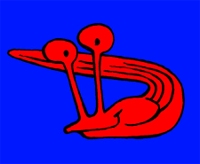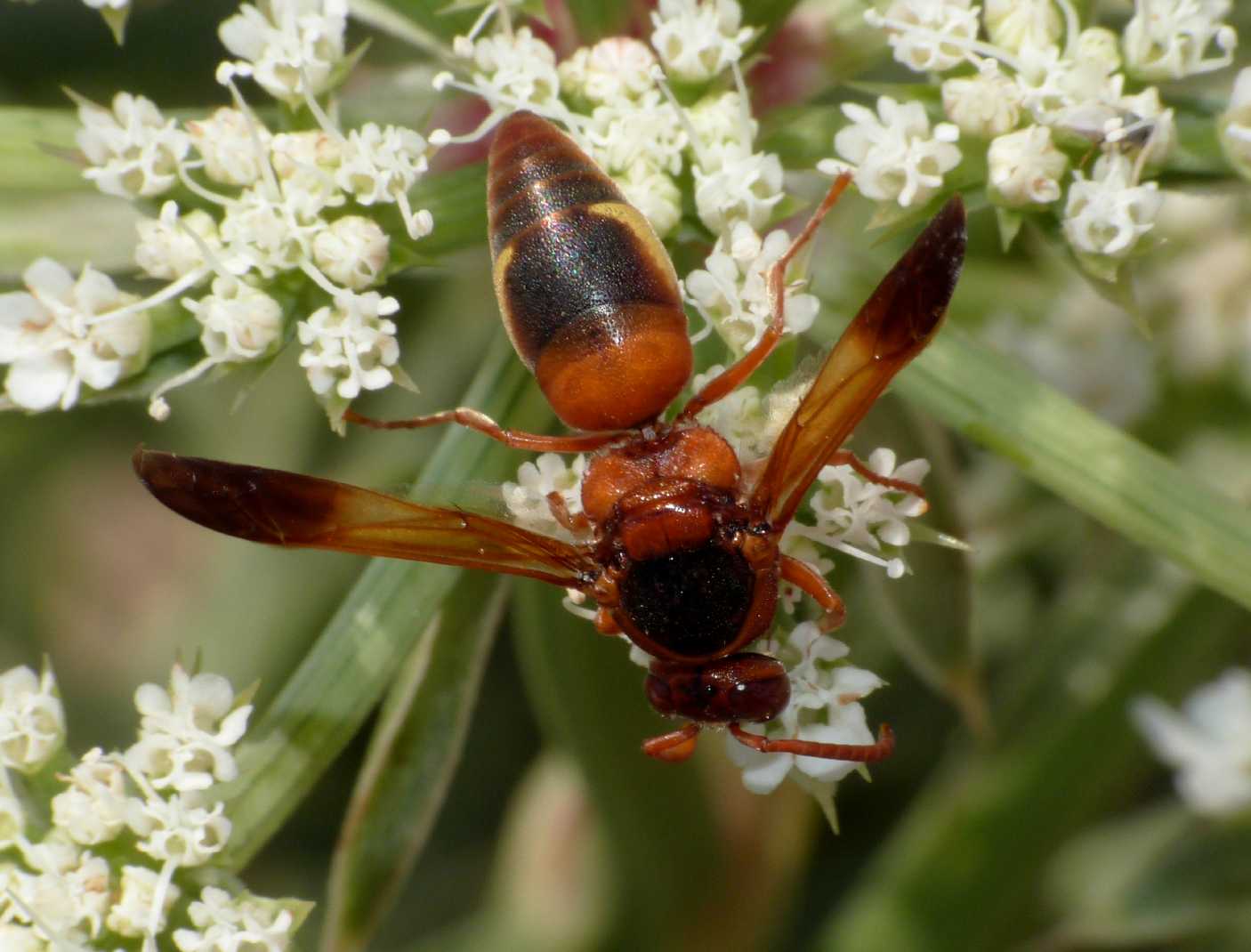|
|
|
|
|
Galleria Tassonomica
di
Natura Mediterraneo
|
 Nota! La determinazione degli insetti necessita quasi sempre di un'indicazione geografica e temporale precisa. Nota! La determinazione degli insetti necessita quasi sempre di un'indicazione geografica e temporale precisa.
Invitiamo quindi gli utenti ad inserire questi dati ogni volta che viene richiesta una determinazione o viene postata una foto di un insetto. I dati forniti dagli utenti ci consentiranno anche di attribuire un valore scientifico alle segnalazioni, contribuendo a migliorare e integrare le attuali conoscenze sulla distribuzione delle specie postate.
|
|
| Autore |
 Discussione Discussione  |
|
|
Cmb
Moderatore
    

Città: Buers
Prov.: Estero
Regione: Austria

12844 Messaggi
Flora e Fauna |
|
|
elleelle
Moderatore Trasversale
    
Città: roma
Regione: Lazio

32995 Messaggi
Flora e Fauna |
 Inserito il - 19 agosto 2012 : 16:14:10 Inserito il - 19 agosto 2012 : 16:14:10


|
No. E' Delta unguiculatum; il più grande e bello degli Eumenidae, o vespe vasaie.
 luigi luigi
|
 |
|
|
ValerioW
Moderatore
    

Città: Padova
Prov.: Padova
Regione: Veneto

8059 Messaggi
Tutti i Forum |
 Inserito il - 21 agosto 2012 : 17:12:54 Inserito il - 21 agosto 2012 : 17:12:54


|
| L'Eumenidae più grosso in Italia dovrebbe essere Rhynchium oculatum. |
 |
|
|
elleelle
Moderatore Trasversale
    
Città: roma
Regione: Lazio

32995 Messaggi
Flora e Fauna |
 Inserito il - 21 agosto 2012 : 21:55:07 Inserito il - 21 agosto 2012 : 21:55:07


|
Non ho avuto la stessa impressione. Sicuramente, è più corto.
 luigi luigi
Immagine:

93,6 KB
|
 |
|
|
Cmb
Moderatore
    

Città: Buers
Prov.: Estero
Regione: Austria

12844 Messaggi
Flora e Fauna |
 Inserito il - 21 agosto 2012 : 22:33:15 Inserito il - 21 agosto 2012 : 22:33:15


|
Valerio, facciamo cosi: tu fai un sito più bello del tuo favorito - e io sono sicuro che ricevi un grande applauso - è dopo beviamo una bella birra virtuale.
Fin' adesso ho trovato sulla misura sempre la parola "circa"....
Circa una buona fortuna! |
"Good people don't go into government" (D. Trump)

Link - nothing is more dangerous than the truth - solo chi conosce il passato, può capire il presente! - nothing is more dangerous than the truth - solo chi conosce il passato, può capire il presente!
|
 |
|
|
elleelle
Moderatore Trasversale
    
Città: roma
Regione: Lazio

32995 Messaggi
Flora e Fauna |
 Inserito il - 21 agosto 2012 : 22:43:45 Inserito il - 21 agosto 2012 : 22:43:45


|
Mi risulta che gli Eumenidae, a differenza degli Sceliphron, prelevano sempre terra asciutta e la impastano con la saliva.
 luigi luigi
|
 |
|
|
ValerioW
Moderatore
    

Città: Padova
Prov.: Padova
Regione: Veneto

8059 Messaggi
Tutti i Forum |
 Inserito il - 22 agosto 2012 : 16:05:40 Inserito il - 22 agosto 2012 : 16:05:40


|
| Messaggio originario di Cmb:
Valerio, facciamo cosi: tu fai un sito più bello del tuo favorito - e io sono sicuro che ricevi un grande applauso - è dopo beviamo una bella birra virtuale.
Fin' adesso ho trovato sulla misura sempre la parola "circa"....
Circa una buona fortuna!
|
? Ma cosa significa quello che hai scritto? Se hai problemi a spiegarmelo in italiano scrivmelo pure in inglese. |
Modificato da - ValerioW in data 22 agosto 2012 16:09:03 |
 |
|
|
ValerioW
Moderatore
    

Città: Padova
Prov.: Padova
Regione: Veneto

8059 Messaggi
Tutti i Forum |
 Inserito il - 22 agosto 2012 : 16:07:59 Inserito il - 22 agosto 2012 : 16:07:59


|
Rhynchium | Messaggio originario di elleelle:
Mi risulta che gli Eumenidae, a differenza degli Sceliphron, prelevano sempre terra asciutta e la impastano con la saliva.
 luigi luigi
|
Rhynchium sp. sono eumenidi infatti, come correttamente dici tu, cioè "vespe vasaio".
|
 |
|
|
Cmb
Moderatore
    

Città: Buers
Prov.: Estero
Regione: Austria

12844 Messaggi
Flora e Fauna |
 Inserito il - 11 settembre 2012 : 09:01:30 Inserito il - 11 settembre 2012 : 09:01:30


|
Fra poco puo arrivare a casa mia....
Mader D. (2001): Einwanderung der Delta-Lehmwespe Delta unguiculatum (VILLERS 1789) (Hymenoptera: Eumenidae) in das Alpenrheintal (Österreich und Schweiz). - Linzer biol. Beiträge. 33/2 (819-826)
A b s t r a c t : The mediterranean delta mud wasp Delta unguiculatum (VILLERS 1789) (Hymenoptera, Vespoidea, Eumenidae) has wandered from the Mediterranean Sea along the Rhone valley in upstream direction, has then immigrated into the Saone valley and has followed it in upstream direction, and has subsequently further expanded in various side valleys of the Saone in upstream direction towards northeast to north. Via the Doubs, which is the greatest tributary of the Saöne, D. unguiculatum has reached the Burgundian Gate that represents a gently undulating watershed between the Rhine and its tributaries in the east and the Saöne and its tributaries in the west between the Vosges in the north and the Swiss Jurassic in the south. From the Burgundian Gate, D. unguiculatum has entered the Upper Rhine Graben along the Rhine-Rhone-Channel and has then wandered within the Upper Rhine Graben in downstream direction from south to north. From the southern end of the Upper Rhine Graben, D. unguiculatum has also accessed the High Rhine valley and has migrated therein from Basel at the termination of the High Rhine valley into the Upper Rhine Graben in the west up to Stein at the efflux of the High Rhine from Lake Constance in the east, and has then further advanced from west to east along the northern margin of Lake Constance via Radolfzell, Überlingen and Friedrichshafen up to Lindau as well as along the southern margin of Lake Constance via Kreuzungen, Romanshorn and Rorschach up to Lustenau and Bregenz at the termination of the Alpine Rhine into Lake Constance. The easternmost nesting site of D. unguiculatum in the greater surroundings of Lake Constance is located in Wangen in the Allgäu which it has reached by wandering from the margin of Lake Constance along the Argen valley in upstream direction. At the termination of the Alpine Rhine into Lake Constance between Lustenau and Bregenz, D. unguiculatum has immigrated into the Alpine Rhine valley and has advanced therein from north to south up to Oberriet and Riithi north of Feldkirch where its upstream wandering along the Alpine Rhine valley from Lake Constance has actually stopped. Because no mason nests of D. unguiculatum have been found between Oberriet and Riithi north of Feldkirch and Sargans in the Alpine Rhine valley, whereas relatively fresh mason nests have been discovered in Sargans and Chur, D. unguiculatum has arrived in Sargans and Chur not via the Alpine Rhine valley between Lake Constance and Sargans, but has entered the Alpine Rhine valley laterally near Sargans, has then further advanced in the Alpine Rhine valley from north to south in upstream direction, and has thus also reached Chur. This lateral immigration street into the Alpine Rhine valley near Sargans is confirmed by numerous mason nests of D. unguiculatum along a chain of nesting sites in the Seez valley between Alpine Rhine valley and Lake Walen, at the margin of Lake Walen, in the depression of the Linth Channel between Lake Walen and Lake Zürich, and probably also at the margin of Lake Zürich. |
"Good people don't go into government" (D. Trump)

Link - nothing is more dangerous than the truth - solo chi conosce il passato, può capire il presente! - nothing is more dangerous than the truth - solo chi conosce il passato, può capire il presente!
|
 |
|
|
ValerioW
Moderatore
    

Città: Padova
Prov.: Padova
Regione: Veneto

8059 Messaggi
Tutti i Forum |
 Inserito il - 11 settembre 2012 : 12:01:17 Inserito il - 11 settembre 2012 : 12:01:17


|
Nice! It was so hard for me to find it, and it never happened when I was equipped with my camera.
| Messaggio originario di Cmb:
Fra poco puo arrivare a casa mia....
Mader D. (2001): Einwanderung der Delta-Lehmwespe Delta unguiculatum (VILLERS 1789) (Hymenoptera: Eumenidae) in das Alpenrheintal (Österreich und Schweiz). - Linzer biol. Beiträge. 33/2 (819-826)
A b s t r a c t : The mediterranean delta mud wasp Delta unguiculatum (VILLERS 1789) (Hymenoptera, Vespoidea, Eumenidae) has wandered from the Mediterranean Sea along the Rhone valley in upstream direction, has then immigrated into the Saone valley and has followed it in upstream direction, and has subsequently further expanded in various side valleys of the Saone in upstream direction towards northeast to north. Via the Doubs, which is the greatest tributary of the Saöne, D. unguiculatum has reached the Burgundian Gate that represents a gently undulating watershed between the Rhine and its tributaries in the east and the Saöne and its tributaries in the west between the Vosges in the north and the Swiss Jurassic in the south. From the Burgundian Gate, D. unguiculatum has entered the Upper Rhine Graben along the Rhine-Rhone-Channel and has then wandered within the Upper Rhine Graben in downstream direction from south to north. From the southern end of the Upper Rhine Graben, D. unguiculatum has also accessed the High Rhine valley and has migrated therein from Basel at the termination of the High Rhine valley into the Upper Rhine Graben in the west up to Stein at the efflux of the High Rhine from Lake Constance in the east, and has then further advanced from west to east along the northern margin of Lake Constance via Radolfzell, Überlingen and Friedrichshafen up to Lindau as well as along the southern margin of Lake Constance via Kreuzungen, Romanshorn and Rorschach up to Lustenau and Bregenz at the termination of the Alpine Rhine into Lake Constance. The easternmost nesting site of D. unguiculatum in the greater surroundings of Lake Constance is located in Wangen in the Allgäu which it has reached by wandering from the margin of Lake Constance along the Argen valley in upstream direction. At the termination of the Alpine Rhine into Lake Constance between Lustenau and Bregenz, D. unguiculatum has immigrated into the Alpine Rhine valley and has advanced therein from north to south up to Oberriet and Riithi north of Feldkirch where its upstream wandering along the Alpine Rhine valley from Lake Constance has actually stopped. Because no mason nests of D. unguiculatum have been found between Oberriet and Riithi north of Feldkirch and Sargans in the Alpine Rhine valley, whereas relatively fresh mason nests have been discovered in Sargans and Chur, D. unguiculatum has arrived in Sargans and Chur not via the Alpine Rhine valley between Lake Constance and Sargans, but has entered the Alpine Rhine valley laterally near Sargans, has then further advanced in the Alpine Rhine valley from north to south in upstream direction, and has thus also reached Chur. This lateral immigration street into the Alpine Rhine valley near Sargans is confirmed by numerous mason nests of D. unguiculatum along a chain of nesting sites in the Seez valley between Alpine Rhine valley and Lake Walen, at the margin of Lake Walen, in the depression of the Linth Channel between Lake Walen and Lake Zürich, and probably also at the margin of Lake Zürich.
|
|
 |
|
| |
 Discussione Discussione  |
|
|
|
 Natura Mediterraneo Natura Mediterraneo |
© 2003-2024 Natura Mediterraneo |
 |
|
Leps.it | Herp.it | Lynkos.net
|

 Forum
|
Registrati
|
Msg attivi
|
Msg Recenti
|
Msg Pvt
|
Utenti
|
Galleria |
Map |
Forum
|
Registrati
|
Msg attivi
|
Msg Recenti
|
Msg Pvt
|
Utenti
|
Galleria |
Map |